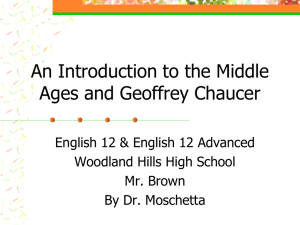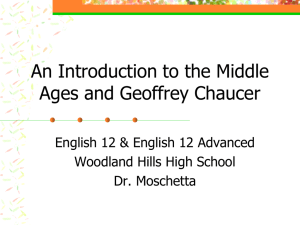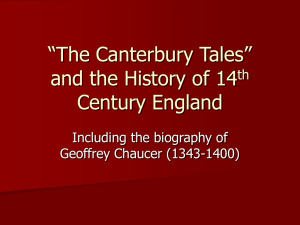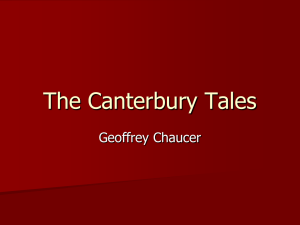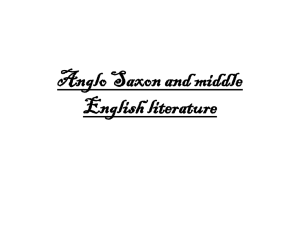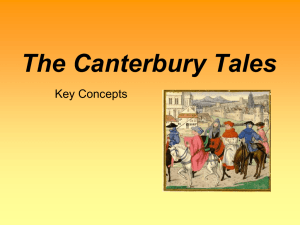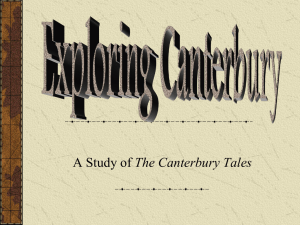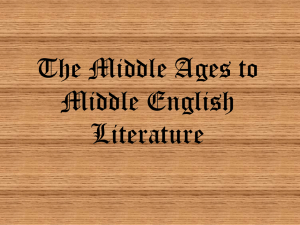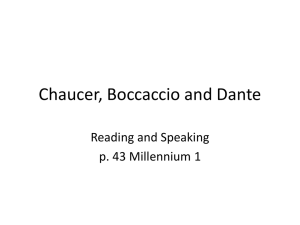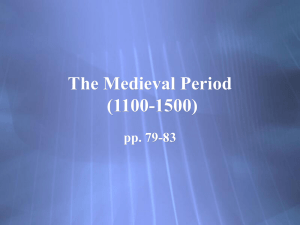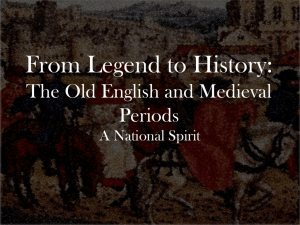Geoffrey Chaucer and The Canterbury Tales
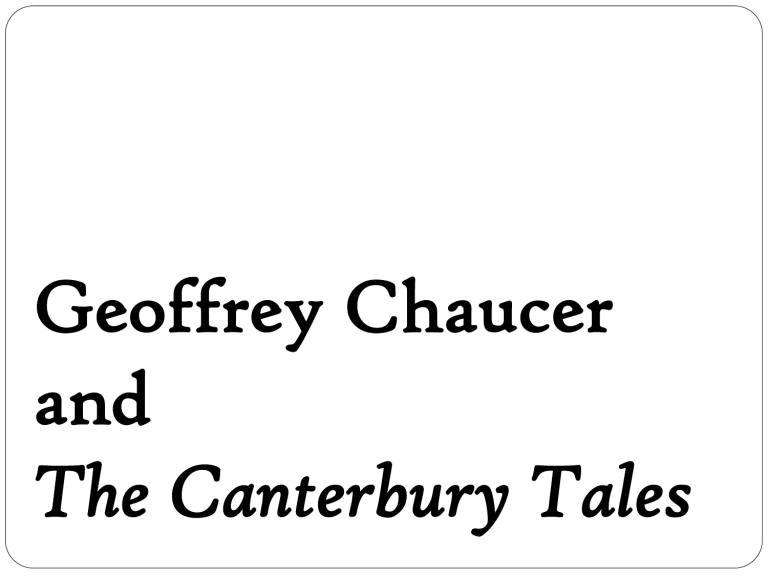
Geoffrey Chaucer and
The Canterbury Tales
Early Life
Born 1340 – Middle Ages.
Son of a prosperous wine merchant – lived among wealthy society.
In his mid-teens, he was placed in the service of the
Countess of Ulster to obtain more education and be schooled in court and society life.
He learned languages during his education –
Latin, Greek, and also some French and Italian.
Early Life (cont.)
In, 1359 he was captured by the French (who were fighting the English during the Hundred Years' War) while serving in English army; King Edward III paid ransom to have him released a year later.
Chaucer joined the royal household and became a trusted messenger and minor diplomat.
As a Royal Messenger
Chaucer was frequently sent throughout Europe on secret business for the King.
Some of these trips were to Italy where he became acquainted with the works of the great Italian authors: Boccaccio, Dante, Petrarch.
• These three were the greatest Italian writers of the early Renaissance period.
• Their influence motivated Chaucer to become a writer.
• Boccaccio’s Decameron in particular is very similar to The Canterbury Tales .
Other Jobs Chaucer Held and Learned From
Controller of Customs on Wools, Skins and Hides for the
Port of London
• Met businessmen, sailors, travelers, city folk and common laborers.
Clerk of the King’s Works
• In charge of construction and repairs affecting the royal residences; he met guildsmen and court officials.
Deputy Forester of the King’s Forests
•
• Away from the city, he met peasants, foresters, local clergy and other country folk.
Learned about how secular some clergy were while far from the control of the King.
Representative of the Shire of Kent in Parliament
• Met the rich and the upper middle class as well as higher ranking church officials.
Chaucer’s Plan ...
A Prologue followed by a series of stories and linking dialogues and commentaries – this is referred to as a frame narrative.
Each character would tell two stories going to and two stories coming home from Canterbury (it was a storytelling contest for entertainment). This plan was not precisely executed though, as
Chaucer did not finish.
Harry Bailey, referred to as The Host in the tales, is assumed to be Chaucer.
London to Canterbury – a trip of about 60 miles
People of all classes went on pilgrimages to holy sites to ask for help with medical, financial, or other problems.
**Canterbury was a Pilgrimage Site**
Where are other places in the world people pilgrimage to for various religions?
What are pilgrims?
Canterbury has always been an important religious center in
England.
St. Augustine (seen in stained glass from the Canterbury
Cathedral) was sent by Pope
Gregory the Great in the sixth century to establish the Catholic faith in England.
Canterbury also contains…
The Shrine of
St. Thomas à Becket
Becket was a trusted adviser and friend of King
Henry II. Henry named Becket Archbishop of
Canterbury.
Becket’s outspoken style angered the King.
One day, Henry complained, “Will no one rid me of this meddlesome priest?”
Three knights rode to
Canterbury where they found Becket at the altar of Canterbury
Cathedral.
Becket was murdered at the altar.
The death of Becket angered the peasants who felt his Saxon heritage made him one of them.
Thus, he became a martyr.
Canterbury Cathedral became a site for pilgrims to offer prayers to St.
Thomas.
Why was religion SO important?
It’s the Middle Ages, and that means:
•
• Plague
Warfare
•
• High Infant Mortality Rate
Short Life Expectancy
• …and if you were a peasant, you lived your whole life under very harsh conditions.
About the best thing that you had to look forward to was dying and going to heaven!
Remember: In The Canterbury Tales , some characters are genuine in their quest for religious help; others just want to go on “spring break” and cause trouble.
The fact that Chaucer wrote in the vernacular
Middle English, rather than French or Latin like many of his fellow writers, meant that ordinary folk could enjoy The Canterbury
Tales and their entertaining characters.
The late fourteenth century world was still very much one of the spoken word.
Books were copied out by hand and were a rare luxury until the advent of the printing press 70 years later. The educated elite could read, but they preferred to hear texts read out loud for entertainment. The
Canterbury Tales , with their earthy humor and vivid dialogue, were a runaway success.
Chaucer surrounded by his characters.
Things to Keep in Mind
In The Canterbury Tales , Chaucer wrote about the people he had met in his life.
He is criticizing most characters, especially religious figures.
Every character has at least one idiosyncrasy, and it is usually negative.
We learn about the characters through direct and indirect characterization.
Think about the types of characters one would meet in a modern-day Canterbury Tales setting – perhaps a road trip. This is something you will be asked to do as a creative project at the end of this unit.
Be on the Lookout For…
How important information about a character can be expressed through appearance and clothing
The seven deadly sins – most characters exhibit at least one: wrath, greed, sloth, pride, lust, envy, and gluttony.
Allusions –What allusions are made to the Bible, mythology, and other literature in order to enhance characterization?
Chaucer’s interjections – they reveal his approval or disapproval of different characters
Different genres of literature in the characters’ tales (more details later)
Different comical strategies in satirizing the characters (more details later)
Impact
Chaucer is the first to …
Use people or characters in real-life terms
Think about the influence reading has on people
Think about the ethical impact of reading
Use literature to criticize society
Be interested in how social conditions make us who we are
Chaucer’s Poetic Format
Heroic Couplets = traditional form for English poetry, commonly used for epic and narrative poetry in particular.
It refers to poems constructed from a sequence of rhyming pairs (couplets – AABB rhyme scheme) in lines of approximate iambic pentameter (5 pairs of unstressed/stressed syllables, 10 total for each line).
The rhyme is always masculine, meaning it ends in a stressed syllable that has a final consonant sound.
O could I flow like thee, and make thy stream
(final consonant sound m)
My great example, as it is my theme!
Though deep yet clear, though gentle yet not dull;
(final consonant sound l)
Strong without rage, without o'erflowing full.
*Count syllables – approximately 10, right?
Chaucer’s Way of Straying
Chaucer is credited with the first widespread use of iambic pentameter.
However, he allowed himself to stray from the heroic couplet form with the occasional use of enjambment, which is:
--The breaking of a syntactic unit (a phrase, clause, or sentence) by the end of a line or between two verses.
--It is to be contrasted with end-stopping, where each linguistic unit corresponds with a single line, and caesura, in which the linguistic unit ends mid-line.
--The term is directly borrowed from the French enjambement, meaning "straddling" or "bestriding." Enjambment is sometimes referred to as a "run-on line” in poetry.
So, let’s travel back to London, to the area called
Southwark, and stop at the Tabard Inn, where the story begins.
Journal Entry –Prologue
In your opinion, in what ways can a person’s clothing express information about them? What are some modern day situations where clothing matters?
Think about the characters we’ve met so far in
The Canterbury Tales who have had some type of clothing description. What points is Chaucer trying to get across about each person based on the different articles of clothing/accessories described?
Journal Entry – Wife of Bath
If you could choose to have an operation that would make you either twice as benevolent
(noble/kind-hearted) or twice as attractive, which would you choose and why? Make sure to consider the possible negative “side effects” of extreme attractiveness and extreme kindness when you make your choice.
What were the Wife of Bath’s thoughts (via the old lady) on the benefits of being old and ugly?
Journal Entry - Miller
Is it ever acceptable to cheat on a significant other? Why/why not? If you do believe it is acceptable, under what circumstances?
What were the circumstances that facilitated cheating in “The Miller’s
Tale”? Do the circumstances make the characters’ actions excusable?
Chaucer’s Genres (popular during his time)
Chivalric romance: a non-scholarly narrative in metrical verse; tale of love, adventure, knightly conflict, and pageantry
Myth: retelling of a classic myth
Breton Lais: set in the Brittany region of France; tales, Celtic in origin, of magic, fairies, folklore, and courtly love
Beast Fable: animal characters with human qualities; clever tale that preaches a moral lesson
Prose Allegory: non-poetic tale in which people and things represent abstract qualities
Mock-Heroic: ridicule, by imitation, of chivalric literature and heroic characters
Mock-Romance: ridicule of chivalric romance by parody
Jokes: humorous incidents that ridicule people
Fabliau: story based on clever tricks involving infidelity
Sermon: an oratory preaching a Christian message
Exemplum: a sermon that illustrates a known moral lesson
Saint’s Legend: tale of inspirational acts or martyrdom
Miracle of the Virgin: tale in which the Virgin Mary miraculously aids a follower in time of need
Moral Tale: tale to inspire moral conduct in the listener
To the Characters!
1. Which character(s) would be likely to tell a chivalric romance?
Answer: Knight, Squire
2. Who might tell a story about a saint?
Answer: One of the nuns or priests
3. Who might tell a joke?
Answer: Miller, Friar, Summoner
4. What type of story is “The Wife of Bath’s Tale”?
Answer: mock-romance; moral tale
5. What type of story is “The Miller’s Tale”?
Answer: fabliau
Chaucer: The Comic Genius
Satire: The act of ridiculing human vices and follies
Humorous, wry, detached; ridicules politics, society, human weaknesses; invents fictitious situations
Mockery: laughter, scorn, and ridicule
Sarcasm: using praise to mock someone personally
Verbal Irony: a double meaning; saying something and meaning something else
Understatement (diminution): implying the opposite by saying less than one means to say
Overstatement (inflation): exaggeration by saying more than one means to say
Bathos: going quickly from the sublime or serious to the ridiculous
Juxtaposition: the purposeful placement of opposite characters to highlight absurdities
Satire
Identifying Satiric Devices in Context (from Prologue)
1.
o
Physician: “Gold stimulates the heart, or so we’re told. He therefore had a special love of gold.
irony
2.
o
Pardoner: “He said he had a gobbet of the sail/Saint Peter had the time when he made bold/To walk the waves, till Jesu Christ took hold. /He had a cross of metal set with stones/And, in a glass, a rubble of pigs’ bones.” bathos
3.
o
Clerk: “…his horse was thinner than a rake,/And he was not too fat, I undertake …” understatement
4.
o
Friar: “He was a noble pillar to his Order.” sarcasm
Identifying Satiric Devices in Context (from Prologue)
5. Miller: “A wrangler and a buffoon, he had a store /Of tavern stories, filthy in the main./His was a master-hand at stealing grain.”
overstatement, sarcasm, mockery
6. Summoner: “Garlic he loved, and onions too, and leeks,/And drinking strong wine till all was hazy./Then he would shout and jabber as if crazy,/And wouldn’t speak a word except in Latin/When he was drunk …”
mockery
7. Friar: “He knew the taverns well in every town/And every innkeeper and barmaid too/Better than lepers, beggars and that crew
…”
bathos, irony
Identifying Satiric Devices in Context (from Prologue)
8. Cook: “But what a pity—so it seemed to me,/That he should have an ulcer on his knee./As for blancmange, he made it with the best.”
irony
9. Prioress: “Her forehead, certainly, was fair of spread,/Almost a span across the brows, I own;/She was indeed by no means undergrown.”
understatement
10. The Guildsmen: “Their wisdom would have justified a plan/To make each one an alderman;/They had the capital and revenue,/Besides, their wives declared it was their due.”
bathos
Identifying Satiric Devices in Context (from Prologue)
11. Summoner: “He wore a garland set upon his head/Large as the holly-bush upon a stake/Outside an ale-house, and he had a cake,/A round one, which it was his joke to wield/As if it were intended for a shield.”
overstatement, mockery
12. Miller: “His beard, like any sow or fox, was red/And broad as well, as though it were a spade;/And, at its very tip, his nose displayed/A wart on which there stood a tuft of hair/Red as the bristles in an old sow’s ear.”
mockery, sarcasm

